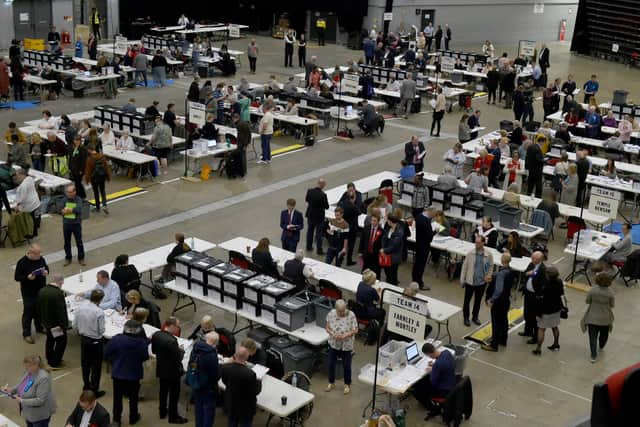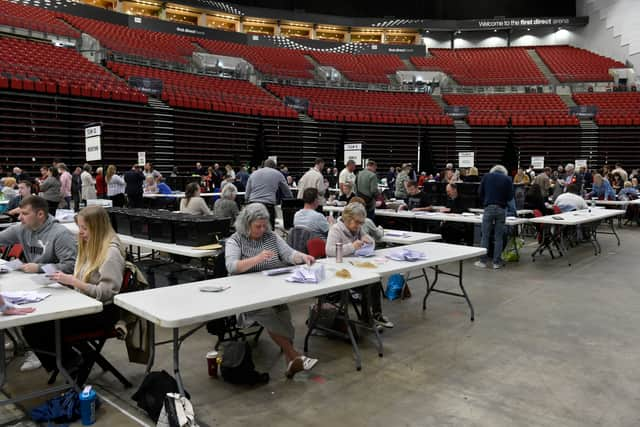Leeds council election results live: Every councillor elected in 2022 vote as count takes place
and live on Freeview channel 276
Follow our live blog below for the latest news from the count at Leeds First Direct Arena and refresh the page for updates.
Leeds local election results live: Every councillor elected in 2022 vote as count takes place
Counting now under way
The count has begun at Leeds First Direct Arena, with the first results expected at around 11.30am and the final results likely to be declared by around 4.30pm.




What does it take to secure a majority on the council?
Leeds has a total of 99 council seats – with 33 wards each represented by three councillors. For these local elections, one seat from each ward will be up for grabs as well as the two extra seats where a councillor stood down.
For a working majority, a party must hold at least 50 seats – this effectively means they can take control of the council.
If no one party has overall control, this means an agreement would have to take place between parties to either support a minority administration or to form a coalition.
Following the 2021 local elections, Leeds’ Labour group boasted 54 councillors, and is now down to 53 following Paul Drinkwater’s resignation from the party. This means Labour has only three councillors above the 50 it needs for a controlling majority.
The Leeds council seats to watch
Local Democracy Reporter David Spereall has taken a look at the seats with the slimmest majorities, according to the last results we have for them. He writes:
These numbers come with a couple of caveats, as obviously the local elections results from last year would offer a better snapshot of the current political climate than 2018.
Another disclaimer: because it was all-out elections, in some wards the party which finished first also finished fourth with one of their other candidates. Therefore the size of the majority itself mightn’t necessarily give a foolproof picture of that party’s likelihood of winning that seat this time around.
Nonetheless, the numbers do offer some level of indication of which seats could potentially be the key political battlegrounds this week.
Weetwood – Liberal Democrat majority of 21
The thinnest majority of any seat up for grabs this year is in Weetwood.
Coun Jonathan Bentley, who was the Liberal Democrats’ group leader, took the most votes here in 2018. He was elected alongside two Labour councillors then, who finished narrowly behind him in the polls.
One of those seats switched to Liberal Democrat in 2019, but Labour held on here in the elections held last year, so this seat could well be close again this time around.
Councillor Bentley himself is standing down for the Lib Dems, however.
Farnley and Wortley – Green majority of 310
Long-serving Green Party councillor Ann Blackburn finished top of the polls in Farnley and Wortley in 2018.
But in a closely-fought battle, just 310 votes separated her and fourth place, with just a further seven votes separating fourth and sixth.
The Greens currently have a full complement of councillors in the ward, having since taken one seat off Labour here in 2019 and seen Anne’s husband and party leader David re-elected last year.
Morley South – Morley Borough Independent (MBI) majority of 398
The MBIs, who want independence for Morley from Leeds City Council, took two of the three seats in the elections of 2018, with Labour’s Neil Dawson finishing second.
It was long-serving MBI councillor Robert Finnigan who missed out in fourth place, though he was back in the council chamber a year later after successfully standing in Morley North.
Pudsey – Conservative majority of 423
Pudsey has been a close fight between the Tories and Labour in years gone by – in 2018 less than 700 votes split six candidates (three from each of the two parties).
The Conservatives have since strengthened their hold in the area however, snatching one seat from Labour and then retaining their own seat by a more comfortable margin of around 2,000 votes last year.
But with Labour enjoying better national polling figures than 12 months ago, the chasm is likely to be far narrower this year.
Ardsley and Robin Hood – Labour majority of 474
Labour won all three council seats in the Ardsley and Robin Hood ward in 2018, but last year lost one of these to the Conservatives.
Coun Karen Renshaw is trying to defend the seat she won with a margin of just under 500 in 2018 for Labour.
Temple Newsam – Labour majority of 528
The council’s deputy leader, Debra Coupar, is seeking re-election in Temple Newsam after finishing in first place four years ago.
It was last year’s polls however which threw up one of the most intriguing local election storylines of recent years, when Labour’s Helen Hayden retained her seat by a wafer-thin 12 votes.It was by far and away the tiniest majority any Leeds councillor was elected with last year.
Interestingly, in the event of a tie between two councillors, lots are drawn to decide who takes the seat.
Horsforth – Conservative majority of 650
As mentioned, there are two seats up for grabs in Horsforth this year. Tory councillor Dawn Collins was elected in first place in 2018 with a majority of 742 above the candidate in fourth.
However, as her party colleague Jonathon Taylor is standing down as a councillor, the Conservatives will be trying to defend his seat as well this year.
Councillor Taylor was elected in Horsforth last year with a majority of exactly 650 votes, ahead of Labour.
The Lib Dems also have history in Horsforth though – they regularly used to win elections here in the pre-Coalition days with the help of its student population.
Counting for Leeds results due to begin
Welcome to the Yorkshire Evening Post’s local elections live blog where we’ll be sharing every Leeds City Council result as it’s declared.
This year’s count is taking place at Leeds First Direct Arena and is due to begin shortly.
A total of 35 council seats are up for grabs – one in each of the city’s 33 wards, plus extra ones in Horsforth and Roundhay, where councillors have stood down before their four-year term is up.
Most of the seats being contested this year though were last fought over in 2018, when all-out elections took place and three candidates were elected in each ward.
The candidate who secured the most votes was handed a four-year term until 2022, with their majority being the difference in votes between them and the candidate who finished fourth.